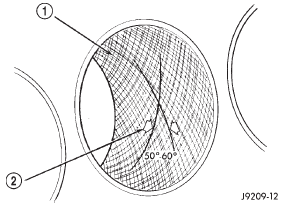Jeep Cherokee (XJ): Engine performance. Honing cylinder bores. Repair damaged or worn threads
It is important that the vehicle is operating to its
optimum performance level to maintain fuel economy
and the lowest emission levels. If vehicle is not operating
to these standards, refer to Engine Diagnosis
outlined in this section. The following procedures can
assist in achieving the proper engine diagnosis.
(1) Test cranking amperage draw. Refer to Electrical
Group 8B, Cold Cranking Test.
(2) Check intake manifold bolt torque; Refer to
Group 11, Exhaust System and Intake Manifold.
(3) Perform cylinder compression test. Refer to
Cylinder Compression Pressure Test in the Engine
Diagnosis area of this section.
(4) Clean or replace spark plugs as necessary and
adjust gap as specified in Electrical Group 8D.
Tighten to specifications.
(5) Test resistance of spark plug cables. Refer to
Electrical Group 8D, Spark Plug Cables.
(6) Inspect the primary wires. Test coil output voltage
and primary resistance. Replace parts as necessary.
Refer to Electrical Group 8D, for specifications.
(7) Test fuel pump for pressure. Refer to Group 14,
Fuel System Specifications.
(8) The air filter elements should be replaced as
specified in Lubrication and Maintenance, Group 0.
(9) Inspect crankcase ventilation system as out
lined in Group 0, Lubrication and Maintenance. For
emission controls see Group 25, Emission Controls
for service procedures.
(10) Road test vehicle as a final test. Before honing, stuff plenty of clean shop towels
under the bores and over the crankshaft to keep
abrasive materials from entering the crankshaft
area.
(1) Used carefully, the Cylinder Bore Sizing Hone
C-823 equipped with 220 grit stones, is the best tool
for this job. In addition to deglazing, it will reduce
taper and out-of-round as well as removing light
scuffing, scoring or scratches. Usually a few strokes
will clean up a bore and maintain the required limits.
CAUTION: DO NOT use rigid type hones to remove
cylinder wall glaze.
(2) Deglazing of the cylinder walls may be done if
the cylinder bore is straight and round. Use a cylinder
surfacing hone, Honing Tool C-3501, equipped
with 280 grit stones (C-3501-3810). 20-60 strokes,
depending on the bore condition, will be sufficient to
provide a satisfactory surface. Using honing oil
C-3501-3880 or a light honing oil available from
major oil distributors.
CAUTION: DO NOT use engine or transmission oil,
mineral spirits or kerosene.
(3) Honing should be done by moving the hone up
and down fast enough to get a crosshatch pattern.
The hone marks should INTERSECT at 50 to 60
for proper seating of rings (Fig. 38).
1 - CROSSHATCH PATTERN (4) A controlled hone motor speed between 200 and
300 RPM is necessary to obtain the proper crosshatch
angle. The number of up and down strokes per
minute can be regulated to get the desired 50 to 60
angle. Faster up and down strokes increase the crosshatch
angle.
(5) After honing, it is necessary that the block be
cleaned to remove all traces of abrasive. Use a brush
to wash parts with a solution of hot water and detergent.
Dry parts thoroughly. Use a clean, white, lintfree
cloth to check that the bore is clean. Oil the
bores after cleaning to prevent rusting. CAUTION: Be sure that the tapped holes maintain
the original center line.
Damaged or worn threads can be repaired. Essentially,
this repair consists of:Engine performance
Honing cylinder bores

Fig. 38 Cylinder Bore Crosshatch Pattern
2 - INTERSECT ANGLERepair damaged or worn threads
 Fitting connecting rod bearings. Fitting crankshaft main bearings. Form-in-place gaskets
Fitting connecting rod bearings. Fitting crankshaft main bearings. Form-in-place gaskets
 Service engine assembly (short
block). Hydrostatic lock. Engine oil service
Service engine assembly (short
block). Hydrostatic lock. Engine oil service
Other materials:
Power steering
Description and operation
STEERING SYSTEM
DESCRIPTION
The power steering system has a hydraulic pump.
The pump is a constant flow rate and displacement,
vane-type pump. The pump on the 4.0L engine has a
reservoir mounted to it (Fig. 1). The 2.5L engine has
a remote mounted reservoir.
The ...
